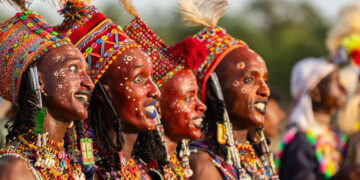Africa, a continent with cultural diversity, and home to some of the world’s most vibrant and fast-growing film industries. These industries have transcended local borders, attracting global audiences and providing a platform for authentic African storytelling.
From Nigeria’s Nollywood to the growing influence of South Africa’s film scene, Africa’s movie industries are not just sources of entertainment but also powerful tools for cultural preservation and economic development.
In this blog post, we’ll discuss the biggest film industries in Africa, highlighting their unique characteristics, contributions, and impact on the global stage.
Top 8 Biggest Film Industries in Africa
1. Nollywood – Nigeria
Nollywood, the nickname for Nigeria’s film industry, is one of the largest film industries globally, both in terms of the number of films produced annually and its cultural impact. With over 2,500 films produced annually, Nollywood ranks second only to India’s Bollywood in terms of output.
The rise of Nollywood can be traced back to the 1990s when low-budget, direct-to-video productions began dominating the market. Movies like Living in Bondage (1992) marked a pivotal point in the industry, setting the stage for the explosion of Nigerian films.
Characteristics
- Low-budget productions: Most Nollywood movies are produced on a tight budget but still manage to resonate deeply with their audience.
- Cultural relevance: The films are rich in African traditions, addressing themes like family, religion, corruption, and love.
- Global Reach: With platforms like Netflix investing in Nollywood originals, Nigerian films now enjoy an international audience.
Economic impact
Nollywood contributes significantly to Nigeria’s economy, employing over a million people directly and indirectly. It also generates an estimated $1 billion annually.
2. South African Film Industry
South Africa boasts one of the most developed film industries in Africa. With a focus on high-quality production and international co-productions, South African cinema has consistently received global acclaim.
The industry gained international recognition with films like Tsotsi (2005), which won the Academy Award for Best Foreign Language Film. The post-apartheid era also spurred the growth of authentic African narratives.
Characteristics
- Advanced infrastructure: South Africa has world-class studios, including Cape Town Film Studios, which attract international filmmakers.
- Diverse storytelling: Films often explore themes of apartheid, reconciliation, and contemporary social issues.
- International collaborations: Co-productions with Hollywood and European filmmakers are common, further enhancing the industry’s reputation.
Economic impact
The South African film industry contributes over R12 billion to the country’s GDP annually and provides thousands of jobs. Initiatives like the South African Film and Television Production Incentive Scheme also encourage local and international productions.
3. Egyptian Film Industry
Egypt’s film industry, often referred to as the “Hollywood of the Middle East,” is the oldest and most established in Africa. It has been the cultural hub for Arabic-speaking nations since the early 20th century.
The golden age of Egyptian cinema spanned from the 1940s to the 1960s, with iconic actors like Omar Sharif and Faten Hamama gaining international fame. The country remains a powerhouse in Arab and African cinema.
Characteristics
- Rich storytelling: Egyptian films often weave together drama, romance, and comedy, reflecting the country’s vibrant culture.
- Arabic influence: As the epicenter of Arabic cinema, Egypt’s films heavily influence storytelling across the Middle East and North Africa.
- Modern advancements: Recent years have seen a rise in independent cinema and more experimental narratives.
Economic impact
The Egyptian film industry has historically been a significant employer and cultural export, with Cairo hosting the annual Cairo International Film Festival, a major event in the Arab world.
4. Kenyan Film Industry
Kenya’s film industry, often referred to as “Riverwood” (a nod to Nigeria’s Nollywood), has been steadily growing over the past two decades. Known for its visually stunning landscapes, Kenya is also a popular location for international productions.
The industry gained global attention with films like The Constant Gardener (2005) and Nairobi Half Life (2012). These films not only showcased Kenyan talent but also shed light on local issues.
Characteristics
- Documentary focus: Many Kenyan filmmakers use the medium to highlight social and political issues.
- Emerging talent: A new generation of filmmakers is bringing fresh perspectives and innovative storytelling techniques.
- International exposure: Partnerships with international studios are helping to elevate Kenyan cinema.
Economic impact
Kenya’s film industry has contributed significantly to tourism, as international productions filmed in the country often highlight its natural beauty. The government has also introduced tax incentives to attract filmmakers.
5. Ghanaian Film Industry (Ghallywood)
Ghana’s film industry, popularly known as Ghallywood, shares similarities with Nollywood but has carved its own identity through unique storytelling and cultural expression.
The industry gained momentum in the 1980s and 1990s, with films like Kukurantumi: Road to Accra (1983) putting Ghanaian cinema on the map.
Characteristics
- Collaborations with Nollywood: Many Ghanaian actors and filmmakers work closely with their Nigerian counterparts.
- Local languages: Films are often produced in local dialects, making them relatable to diverse audiences.
- Digital transformation: The rise of streaming platforms has made Ghanaian films more accessible globally.
Economic impact
Though smaller than Nollywood, Ghallywood contributes to Ghana’s economy by creating jobs and promoting tourism.
6. Moroccan Film Industry
Morocco’s film industry is unique in its blend of Arab, African, and European influences. The country is also a favored location for international productions, thanks to its diverse landscapes and historic cities.
The Moroccan film industry gained prominence with films like Omar Gatlato (1976) and Ali Zaoua (2000), which tackled societal issues with depth and nuance.
Characteristics
- Diverse themes: Films often explore topics ranging from colonial history to modern-day struggles.
- International appeal: Moroccan filmmakers frequently collaborate with European studios, creating films that resonate beyond Africa.
- Film festivals: Events like the Marrakech International Film Festival celebrate Moroccan and global cinema.
Economic impact
Morocco’s film industry has become a significant contributor to the economy, generating income through local productions and hosting international filmmakers.
7. Ethiopian Film Industry
Ethiopia’s film industry, also known as “Kollywood,” has experienced rapid growth in recent years. While relatively small compared to Nollywood, it is gaining traction for its unique storytelling and cultural richness. Ethiopian cinema began gaining popularity in the 2000s, with films like Difret (2014) receiving international acclaim.
Characteristics
- Cultural depth: Ethiopian films often draw from the country’s rich history and traditions.
- Local appeal: Most films are produced in Amharic, catering primarily to a domestic audience.
- Emerging stars: A new wave of filmmakers is experimenting with genres and modern production techniques.
Economic impact
Kollywood is still in its infancy but has the potential to grow into a major industry with government support and increased international partnerships.
8. Tanzanian Film Industry (Bongo Movies)
Tanzania’s film industry, known as “Bongo Movies,” has steadily grown, producing content primarily for local audiences. The industry began to flourish in the early 2000s, with films like Girlfriend and The Return of Uncle JJ paving the way for a vibrant local scene.
Characteristics
- Affordable productions: Most films are made on modest budgets but enjoy widespread popularity.
- Swahili language: Films are predominantly in Swahili, appealing to audiences across East Africa.
- Strong local themes: Stories often revolve around love, family, and societal issues.
Economic impact
The Tanzanian film industry has created jobs and contributed to cultural preservation. With growing regional appeal, Bongo Movies are poised for further expansion.
Conclusion
Africa’s film industries are as diverse as the continent itself, each reflecting the unique cultures, histories, and aspirations of its people. From Nollywood’s global dominance to the artistic depth of Egyptian cinema, these industries are not just sources of entertainment but also vital platforms for storytelling and economic growth.
As technology advances and global interest in African stories increases, these film industries are set to play an even greater role in shaping the narrative of a dynamic and evolving continent. The future of African cinema is undoubtedly bright, promising new opportunities for filmmakers and audiences alike.





































Discussion about this post